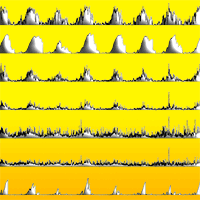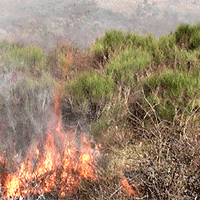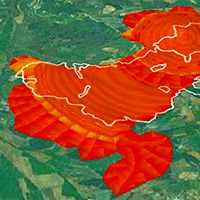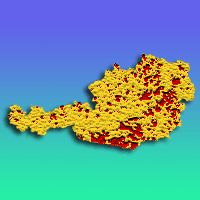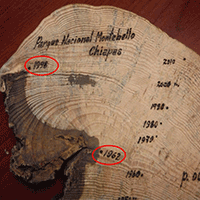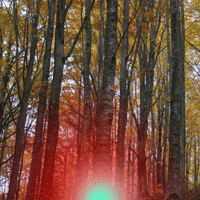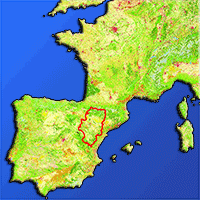
Wildland fire typologies and extreme temperatures in NE Spain
Adrián Cardil , David Merenciano, Domingo Miguel Molina-Terrén
iForest - Biogeosciences and Forestry, Volume 10, Issue 1, Pages 9-14 (2016)
doi: https://doi.org/10.3832/ifor1939-009
Published: Nov 01, 2016 - Copyright © 2016 SISEF
Research Articles
Abstract
Understanding instrumental factors dealing with the development of large wildland fires is a need. Fire spread typologies and extreme temperature days were studied in the 1978-2012 period in Aragón (NE Spain). Temperature was examined at 850 hPa to characterize the low troposphere state and wildfires were grouped in three fire spread typologies: convective fires, wind-driven fires and topography-driven fires. The analysis of wildland fire propagation typologies revealed that convective fires burned the majority of total area burned, resulting in the larger and the most closely typology related to high temperature days (HTDs). Drought Code (DC) correlation with HTDs and wildland fire size was weak.
Keywords
Wildland Fire, Fire Spread Patterns, Forestry, Heat Waves, Climate Change
Authors’ Info
Authors’ address
David Merenciano
Domingo Miguel Molina-Terrén
School of Agrifood and Forestry Science and Engineering, University of Lleida (Spain)
Corresponding author
Paper Info
Citation
Cardil A, Merenciano D, Molina-Terrén DM (2016). Wildland fire typologies and extreme temperatures in NE Spain. iForest 10: 9-14. - doi: 10.3832/ifor1939-009
Academic Editor
Davide Ascoli
Paper history
Received: Dec 09, 2015
Accepted: Aug 16, 2016
First online: Nov 01, 2016
Publication Date: Feb 28, 2017
Publication Time: 2.57 months
Copyright Information
© SISEF - The Italian Society of Silviculture and Forest Ecology 2016
Open Access
This article is distributed under the terms of the Creative Commons Attribution-Non Commercial 4.0 International (https://creativecommons.org/licenses/by-nc/4.0/), which permits unrestricted use, distribution, and reproduction in any medium, provided you give appropriate credit to the original author(s) and the source, provide a link to the Creative Commons license, and indicate if changes were made.
Web Metrics
Breakdown by View Type
Article Usage
Total Article Views: 51884
(from publication date up to now)
Breakdown by View Type
HTML Page Views: 42308
Abstract Page Views: 3955
PDF Downloads: 4273
Citation/Reference Downloads: 52
XML Downloads: 1296
Web Metrics
Days since publication: 3355
Overall contacts: 51884
Avg. contacts per week: 108.25
Citation Metrics
Article Citations
Article citations are based on data periodically collected from the Clarivate Web of Science web site
(last update: Mar 2025)
Total number of cites (since 2017): 12
Average cites per year: 1.33
Publication Metrics
by Dimensions ©
Articles citing this article
List of the papers citing this article based on CrossRef Cited-by.
References
Iberian climate atlas. Air temperature and precipitation (1971-2000). State meteorological Agency of Spain and Department of Meteorology and Climatology of the Institute of Meteorology, Portugal. Ministerio de Medio Ambiente y Medio Rural y Marino, Madrid, Spain, pp. 80.
Gscholar
Tipificación de los incendios forestales de Cataluña. Elaboración del mapa de incendios de diseño como herramienta para la gestión forestal [Wildland fire typologies in Catalonia. Fire mapping design as a tool for forest management]. In: Proceedings of “5° Congreso Forestal Español”. Ávila (Spain), 21-25 Sep 2009. pp. 16. [in Spanish]
Gscholar
The NCEP/NCAR 40-year reanalysis project. Bulletin of the American Meteorological Society 77: 437-471.
CrossRef | Gscholar
Análisis meteorológico de incendios históricos para la determinación y seguimiento diario de los incendios tipo en Aragón [Analysis of historical fire weather for determining and monitoring daily fire typologies in Aragón]. Msc Thesis, Escuela Técnica Superior de Ingeniería Agraria, Lleida, Spain, pp. 91. [in Spanish]
Gscholar
Meteorología sinóptica y comportamiento del fuego en Aragón [Synoptic meteorology and fire behavior in Aragon]. Dirección General Gestión Forestal, Caza y Pesca, Gobierno de Aragón, Zaragoza, Spain, pp. 72. [in Spanish]
Online | Gscholar
Adapting to global change: Mediterranean forests. IUCN Centre for Mediterranean Cooperation, Malaga, Spain, pp. 254
Gscholar



